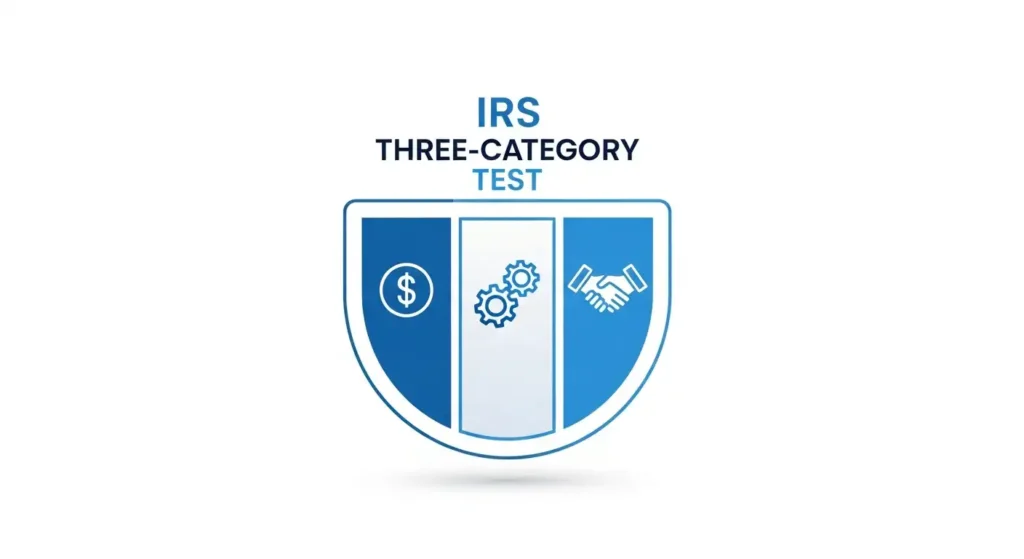IRS Three-Category Test Calculator
IRS Worker Classification Calculator
Found our Free IRS Three-Category Test Calculator useful? Bookmark and share it.

A Quick Guide to the IRS Three-Category Test
Understanding the difference between an employee and an independent contractor is one of the most critical responsibilities for any business. The IRS Three-Category Test is the primary framework for making this determination for federal tax purposes. Correctly applying this test helps businesses avoid the severe financial penalties and legal risks associated with worker misclassification. This guide provides a comprehensive breakdown of the test, including the key factors of Behavioral Control, Financial Control, and the Type of Relationship, to ensure your business remains compliant.
TL;DR
The IRS uses the Three-Category Test to determine if a worker is an employee or an independent contractor. This test isn't a simple checklist; it's a holistic review of the entire work relationship. The three core areas are:
- Behavioral Control: Does the business have the right to direct and control how the worker does their job? This includes providing instructions and training.
- Financial Control: Does the business control the economic aspects of the worker's job? This involves looking at the worker's investment, unreimbursed expenses, and opportunity for profit or loss.
- Type of Relationship: How do the parties perceive their relationship? This is shown through written contracts, employee benefits, and the permanency of the relationship.
Misclassifying a worker can lead to massive liabilities, including back taxes, penalties, and interest. Businesses must also be aware of stricter state-level tests, like the ABC test, which can create additional compliance challenges.
Article Index
- The Critical Importance of Worker Classification
- The Foundation: Common Law and the "Right to Control"
- Deconstructing the Three-Category Test
- The Art of Application: A Holistic Assessment
- Navigating Uncertainty and Seeking Resolution
- The High Stakes of Misclassification
- Pathways to Compliance and Relief
- The Broader Regulatory Landscape: Beyond the IRS
- Strategic Recommendations for Compliant Classification
- Simplify Your Payroll and Reporting
The Critical Importance of Worker Classification
The determination of whether a service provider is an employee or an independent contractor is one of the most fundamental and high-stakes decisions a business can make. This classification is not a mere administrative formality; it is a foundational legal and financial determination that dictates a host of obligations, liabilities, and risks. The distinction permeates nearly every aspect of the business-worker relationship, from tax responsibilities and benefit eligibility to legal protections and operational control. For federal tax purposes, the Internal Revenue Service (IRS) provides a framework rooted in common law to guide this critical analysis.
The consequences are profound. When a worker is an employee, the employer must withhold income taxes, withhold and pay Social Security and Medicare (FICA) taxes, and pay federal unemployment (FUTA) taxes. Conversely, for an independent contractor, the payer's main duty is to issue a Form 1099-NEC for payments over $600. The contractor is self-employed and handles their own taxes. Given the cost savings, businesses may favor contractor status, but the IRS and Department of Labor (DOL) are cracking down on misclassification, which can lead to staggering liabilities.
The Foundation: Common Law and the "Right to Control" Doctrine
The IRS's framework is rooted in "common law rules" developed by courts, now streamlined into the three-category test. At the heart of this analysis is a single principle: the right to control. The central question is whether the business has the right to direct and control how the worker performs their services. It's crucial to understand that the business doesn't need to actually exercise this control; simply retaining the right to do so is enough to suggest an employer-employee relationship. This doctrine reflects that an entity controlling the work process also accepts the associated financial and legal risks.
Deconstructing the Three-Category Test: A Factor-by-Factor Analysis
To properly apply the common law rules, a business must conduct a thorough examination of the facts and circumstances of its relationship with a worker, weighing the evidence within three distinct but interrelated categories. No single fact is determinative; rather, the complete picture of the relationship governs the outcome.
Behavioral Control – The Right to Direct the "How"
This category is often the most influential because it directly addresses the "right to control" doctrine. It scrutinizes whether the business can direct and control the means and methods by which work is achieved.
The Nature and Degree of Instructions
Extensive instructions on when, where, and how to work point toward employee status. This includes dictating work hours, tools to use, or the sequence of tasks. Instructions limited to the final product are more typical of a contractor relationship.
Evaluation Systems: Measuring Process vs. Results
An evaluation system that measures adherence to the business's methods suggests an employee relationship. A system focused solely on the end result is more consistent with a contractor.
Training as an Indicator of Control
Providing training is a powerful indicator of an employer-employee relationship. It shows the business is investing in having the work done according to its specific methods. Independent contractors are expected to have pre-existing expertise.
Financial Control – The Economic Realities of the Job
This category assesses the business's right to control the economic aspects of the worker's job. The central question is whether the worker operates as an independent business entity.
Significant Investment: Skin in the Game
An independent contractor often has a significant investment in the equipment and facilities needed for their work. However, the absence of a large investment isn't determinative, as some professions don't require it.
Unreimbursed Expenses: Who Bears the Cost of Doing Business?
Contractors are more likely to have significant unreimbursed business expenses and ongoing overhead costs. These demonstrate that the worker is maintaining an independent business.
The Opportunity for Profit or Loss
This is a cornerstone of financial control. A contractor has a genuine opportunity to realize a profit or incur a loss based on their own managerial decisions. Employees are generally paid a wage and shielded from business losses.
Availability to the Market: Operating an Independent Business
A worker who makes their services available to the relevant market—through advertising, a website, or serving multiple clients—is likely a contractor.
Method of Payment: Salary/Wage vs. Flat Fee
Employees are typically paid on a recurring basis (hourly, weekly), suggesting the business is buying their time. Contractors are more often paid a flat fee for a specific project, reinforcing that the business is buying a result.
Type of Relationship – The Parties' Intent and Perception
This final category examines how the parties themselves perceive and structure their relationship, looking at agreements, benefits, and the permanency of the engagement.
The Role and Limitations of Written Contracts
A written contract defining the worker as an independent contractor is important evidence of intent. However, the IRS and courts will always prioritize the substance of the relationship over the contract's language. If the actual practices reflect an employer-employee relationship, the contract will be disregarded.
Provision of Employee-Type Benefits
Providing benefits like health insurance, paid leave, or a 401(k) is a compelling indicator of an employment relationship. It is highly unusual for a business to provide such benefits to a contractor.
Permanency: Indefinite Engagement vs. Project-Based Work
A relationship expected to continue indefinitely is characteristic of employment. A relationship for a specific project or a finite period is more typical for a contractor.
Key Aspect of the Business: Integral vs. Ancillary Services
If a worker provides services that are a core part of the company's regular operations, it's more likely they are an employee. For example, a law firm hiring an attorney. If the services are ancillary, like hiring a plumber, a contractor relationship is more likely.
| Factor | Indicates Employee Status | Indicates Independent Contractor Status |
|---|---|---|
| BEHAVIORAL CONTROL | ||
| Instructions | Business provides extensive instructions on how, when, and where to work; dictates methods and sequence. | Business provides instructions only related to the final result or specifications of the deliverable. |
| Evaluation | Evaluation system measures the details of how the work is performed and adherence to process. | Evaluation is based solely on the final outcome or acceptance of the end product. |
| Training | Business provides training to the worker on its procedures and methods. | Worker possesses all necessary skills and training prior to engagement; uses their own methods. |
| FINANCIAL CONTROL | ||
| Significant Investment | Business provides most of the tools, equipment, and facilities needed to perform the work. | Worker has a significant investment in their own tools, equipment, and facilities. |
| Unreimbursed Expenses | Most business and travel expenses are reimbursed by the business. | Worker has significant unreimbursed business expenses and ongoing overhead costs. |
| Opportunity for Profit/Loss | Worker is paid a regular wage/salary and is insulated from business losses. | Worker can realize a profit or incur a loss based on their own management of revenues and expenses. |
| Availability to Market | Worker typically provides services exclusively to the business. | Worker makes their services available to the general public or relevant market; may have multiple clients. |
| Method of Payment | Worker is paid a regular wage on an hourly, weekly, or monthly basis. | Worker is typically paid a flat fee for a specific project or job. |
| TYPE OF RELATIONSHIP | ||
| Written Contract | Contract may exist, but the reality of the relationship reflects control by the business. | A well-drafted contract clearly states the independent contractor relationship and intent. |
| Employee Benefits | Business provides benefits such as health insurance, paid vacation, sick leave, or a pension plan. | No employee-type benefits are provided; worker is responsible for their own insurance and retirement. |
| Permanency | Relationship is continuous and expected to continue indefinitely. | Relationship is for a specific project or a defined, finite period. |
| Key Aspect of Business | Services provided are a key, integral part of the business's regular operations. | Services provided are ancillary or supportive to the business's main activities. |
The Art of Application: A Holistic and Nuanced Assessment
Properly applying the three-category test requires a qualitative judgment based on a holistic review of the entire working relationship. The IRS does not use a scoring system; instead, it weighs the evidence to determine the overall character of the engagement based on the "totality of the circumstances." The relative importance of any single factor can vary by occupation and industry.
Common Scenarios and Misconceptions
- Remote Work: Remote workers are not automatically independent contractors. The "right to control" test applies regardless of physical location.
- Part-Time Status: The number of hours worked is not a determining factor. An individual can be a part-time employee.
- Form 1099 vs. W-2: The tax form used is a consequence of the classification, not a determinant of it. You cannot make an employee a contractor simply by issuing a 1099.
Documenting the Determination: Building a Defensible Position
Meticulous documentation is a business's best defense. Before engaging a worker as a contractor, conduct and document a thorough analysis using the three-category framework. This record should detail the facts supporting the decision for each relevant factor. This forces a rigorous analysis and provides objective evidence of due diligence in case of an audit.
Navigating Uncertainty and Seeking Resolution
For businesses facing genuine uncertainty, the IRS provides a formal process for obtaining an official determination through Form SS-8, "Determination of Worker Status."
A Deep Dive into Form SS-8
This detailed questionnaire can be filed by either the business or the worker. The IRS reviews the submission, typically requests input from the other party, and then issues a formal determination. The process can take six months or longer. While this provides a definitive answer, filing a Form SS-8 directly alerts the IRS to a potential classification issue, which can invite broader scrutiny.
The High Stakes of Misclassification
The financial and legal consequences of misclassifying an employee as an independent contractor can be severe, impacting both the business and the worker.
Consequences for the Business
- Liability for Unpaid Employment Taxes: The business can be held liable for federal income taxes, both the employer and employee shares of FICA taxes, and FUTA taxes.
- IRS Penalties: Penalties can be significant. For unintentional misclassification, they can be a percentage of wages and FICA taxes. For intentional or fraudulent misclassification, the business can be liable for 100% of the taxes, plus additional penalties and potential criminal charges.
- Interest and Other Liabilities: Interest accrues on all unpaid taxes. Beyond the IRS, a business may face liability for back pay for overtime under the FLSA, the value of denied employee benefits, and class-action lawsuits.
Consequences for the Worker
Misclassification also has significant negative consequences for workers, including a higher tax burden (paying the full self-employment tax) and the loss of critical legal protections and benefits like unemployment insurance, workers' compensation, minimum wage and overtime protections, and employer-sponsored health and retirement plans.
Pathways to Compliance and Relief
For businesses that recognize potential misclassification issues, the IRS offers programs to facilitate compliance and mitigate financial consequences.
The Voluntary Classification Settlement Program (VCSP)
The VCSP allows eligible businesses to voluntarily reclassify workers as employees for future periods. In return, the business pays only 10% of the employment tax liability for the most recent tax year, with no interest or penalties, and will not be subject to an employment tax audit for prior years for that class of workers.
Section 530 Relief: The "Reasonable Basis" Safe Harbor
Section 530 of the Revenue Act of 1978 provides a "safe harbor" that can relieve a business from liability if it can demonstrate a "reasonable basis" for the contractor classification. This requires showing the decision was based on a justification like a judicial precedent, a previous IRS audit, or a long-standing industry practice, and that all reporting (like filing 1099s) was consistent.
The Broader Regulatory Landscape: Beyond the IRS Test
The IRS test is not the only standard. Both the U.S. Department of Labor and many states use different, often stricter, tests.
The Department of Labor's "Economic Realities" Test
For federal labor laws like the FLSA, the DOL uses an "economic realities" test. Its focus is not on control but on whether the worker is economically dependent on the business or is truly in business for themselves.
The State-Level "ABC Test": A Stricter Standard
A growing number of states, including California and New Jersey, use the rigid ABC test. This test presumes a worker is an employee unless the business can prove all three of the following:
- The worker is free from the control and direction of the hiring entity.
- The worker performs work that is outside the usual course of the hiring entity's business.
- The worker is customarily engaged in an independently established trade, occupation, or business.
Passing this test, especially prong (B), is significantly harder than passing the IRS test.
| Criterion | IRS Common Law Test | DOL Economic Realities Test | State ABC Test |
|---|---|---|---|
| Primary Jurisdiction | Federal Employment & Income Tax | Federal Labor Law (FLSA) | State Wage & Hour, Unemployment, Workers' Comp |
| Legal Presumption | No presumption; based on weighing facts. | No presumption; based on weighing facts. | Worker is presumed to be an Employee. |
| Core Focus | The business's right to control the worker. | The worker's economic dependence on the business. | Whether the worker operates an independent business. |
| Test Structure | Flexible, facts-and-circumstances balancing test. | Flexible, facts-and-circumstances balancing test. | Rigid, three-pronged test. Must pass all three. |
| Primary Hurdle | Demonstrating a lack of the right to control. | Demonstrating worker is not economically reliant on payer. | Proving work is outside the usual course of business (Prong B). |
Strategic Recommendations for Compliant Worker Classification
The accurate classification of workers is a complex but non-negotiable aspect of legal and financial compliance. To navigate this landscape successfully, businesses must adopt a proactive, rigorous, and well-documented approach.
- Conduct Regular Audits: Review all independent contractor relationships annually to ensure they haven't evolved into an employer-employee dynamic.
- Use a Comprehensive Checklist: Develop a detailed checklist based on the IRS three-category test and, if applicable, the stricter state ABC test.
- Document Every Determination: Maintain a dedicated file for each contractor with the checklist, a summary of your reasoning, and the signed contract.
- Draft Clear Contracts: Use well-drafted contracts that clearly define the independent contractor relationship and terms.
- When in Doubt, Consult Expert Counsel: Seek guidance from experienced tax and employment legal counsel for any "gray area" classifications.
Navigate Payroll Complexity with Confidence
Proper worker classification is just one piece of the payroll puzzle. TimeTrex offers powerful, intuitive payroll reporting tools to help you manage taxes, generate accurate reports, and maintain compliance with ease. Discover how our solutions can streamline your operations.
Explore Payroll Reporting FeaturesDisclaimer: The content provided on this webpage is for informational purposes only and is not intended to be a substitute for professional advice. While we strive to ensure the accuracy and timeliness of the information presented here, the details may change over time or vary in different jurisdictions. Therefore, we do not guarantee the completeness, reliability, or absolute accuracy of this information. The information on this page should not be used as a basis for making legal, financial, or any other key decisions. We strongly advise consulting with a qualified professional or expert in the relevant field for specific advice, guidance, or services. By using this webpage, you acknowledge that the information is offered “as is” and that we are not liable for any errors, omissions, or inaccuracies in the content, nor for any actions taken based on the information provided. We shall not be held liable for any direct, indirect, incidental, consequential, or punitive damages arising out of your access to, use of, or reliance on any content on this page.
Trusted By
Trusted by 3.2M+ Employees: 21 Years of Service Across Startups to Fortune 500 Enterprises
Join our ever-growing community of satisfied customers today and experience the unparalleled benefits of TimeTrex.










Strength In Numbers
Join The Companies Already Benefiting From TimeTrex
Time To Clock-In
Start your 30-day free trial!
Experience the Ultimate Workforce Solution and Revolutionize Your Business Today
- Eliminate Errors
- Simple & Easy To Use
- Real-time Reporting

Saving businesses time and money through better workforce management since 2003.
Copyright © 2025 TimeTrex. All Rights Reserved.
